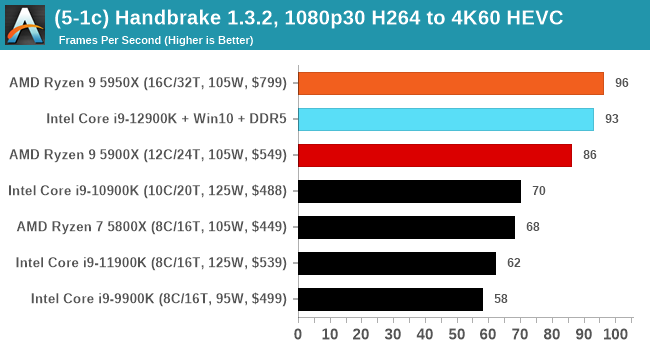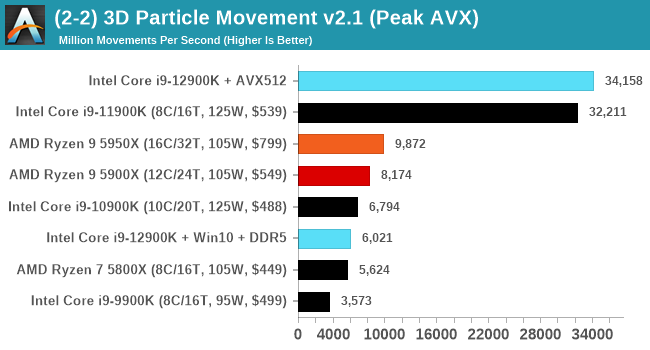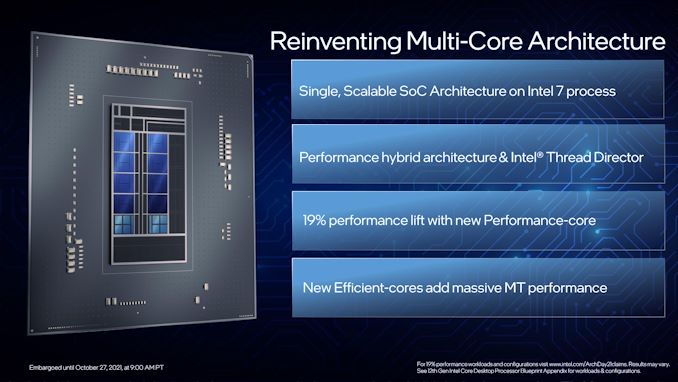The Intel 12th Gen Core i9-12900K Review: Hybrid Performance Brings Hybrid Complexity
by Dr. Ian Cutress & Andrei Frumusanu on November 4, 2021 9:00 AM ESTConclusion: Variables Maketh the CPU
Suffice to say, Intel’s new 12th Generation Core family has added more variables to the mix than a traditional processor launch. The combination of different types of core, coming at a time where a new operating system has just been launched, but also at the inflection point of a new type of memory. Let’s break down some of the differences we’ve observed in our testing.
When we compare Windows 10 to Windows 11, purely on throughput benchmarks, we don’t find much difference. There are a few spots where Windows 11 has a slight advantage in multi-threaded workloads, but this comes down to how new threads are spawned between the performance cores and the efficiency cores. Intel stated that the performance between the two, at least for CPU workloads, should be within a few percentage points, stating that Windows 11 should have lower run-to-run variance. We can corroborate this in our testing. Windows 10 also had some scheduling issues with low priority threads, which we expect to be ironed out with updates.
Comparing the new DDR5 to the old DDR4 is a different story, as the new memory standard offers a substantial uplift when it comes to memory bandwidth. As we saw recently with the M1 Max review, sometimes memory bandwidth can be a limiting factor. In our testing, DDR5 had a minor lead in single threaded tests but in a lot of multithreaded tests, the lead was significant. For real world, we had examples of +14% in Agisoft, +10% in NAMD, +8% in V-Ray, +10% in Handbrake, and +20% in WinRAR. In SPEC2017, we saw a couple of single threaded workloads get +15% improvements over DDR5, but in multi-threaded this was up to +40% on average, or more than 40% in specific tests. This also comes down to the doubled memory channels (4x32-bit vs 2x64-bit) which can be better utilized on top of the bandwidth increases.
Now comparing the P-core to the E-core, and it’s a story of how the E-core individually can perform on par with a Skylake core. Having eight extra Skylake-class cores is nothing to be sniffed at. In a lot of tests the E-core is half the performance of the P-core, but the P-core is itself is now the market leader in performance. The Golden Cove core inside Alder Lake has reclaimed the single-threaded performance crown with an uplift in SPEC of 18-20%, which is in line with Intel’s 19% claim. This puts it ahead of Apple’s M1 Max or 6% (int) and 16% (fp) ahead of AMD’s Zen 3 core.
The Core i9-12900K
Combining fast P-cores, Skylake-class E-cores, and DDR5 into one package means that Intel has certainly jumped from behind the competition to in front of it, or at least in the mix. When you have your operating system set up just right, and no issues with schedulers, it outperforms AMD’s offering when single core performance matters, and in multi-threaded workloads, it does tend to sit somewhere between a 5900X and a 5950X.

It’s important to note that in some tests, the Core i9-12900K does win outright. It’s at this point we should consider how much is core related vs standards related: DDR5 has produced somewhat of an uplift, and the competition is expected to claw some of that back when they introduce it, but those products are expected more towards the latter half of 2022. For users with those specific workloads today, and willing to pay the DDR5 early adopter tax, Alder Lake can provide performance uplifts right now.

Power is an interesting topic, and although our peak power numbers when all cores were loaded were above the 241W Turbo power on the box, in real world workloads it didn’t tend to go that high. The P-cores alone on the chip matched the power consumption of Intel’s 11th Generation in AVX2 workloads, but adding in the E-cores does put it over the previous generation. I’m not entirely sure what that says about Intel’s 7 manufacturing process compared to the 10SF used before. A lot of the performance gains here appear to come from IPC and DDR5, and that doesn’t seem to have come with performance per watt gains on the P-cores. It means that Intel is still losing on power efficiency at load compared to the competition.

I have to say a side word about AVX-512 support, because we found it. If you’re prepared to disable the E-cores, and use specific motherboards, it works. After Intel spent time saying it was fused off, we dug into the story and found it still works for those that need it. It’s going to be interesting to hear how this feature will be discussed by Intel in future.
Overall though, it’s no denying that Intel is now in the thick of it, or if I were to argue, the market leader. The nuances of the hybrid architecture are still nascent, so it will take time to discover where benefits will come, especially when we get to the laptop variants of Alder Lake. At a retail price of around $650, the Core i9-12900K ends up being competitive between the two Ryzen 9 processors, each with their good points. The only serious downside for Intel though is cost of switching to DDR5, and users learning Windows 11. That’s not necessarily on Intel, but it’s a few more hoops than we regularly jump through.











474 Comments
View All Comments
Oxford Guy - Sunday, November 7, 2021 - link
‘or maybe switch off their E-cores and enable AVX-512 in BIOS’This from exactly the same person who posted, just a few hours ago, that it’s correct to note that that option can disappear and/or be rendered non-functional.
I am reminded of your contradictory posts about ECC where you mocked advocacy for it (‘advocacy’ being merely its mention) and proceeded to claim you ‘wish’ for more ECC support.
Once again, it’s helpful to have a grasp of what one actually believes prior to posting. Allocating less effort to posting puerile insults and more toward substance is advised.
mode_13h - Sunday, November 7, 2021 - link
> This from exactly the same person who posted, just a few hours ago, that it’s> correct to note that that option can disappear and/or be rendered non-functional.
You need to learn to distinguish between what Intel has actually stated vs. the facts as we wish them to be. In the previous post you reference, I affirmed your acknowledgement that the capability disappearing would be consistent with what Intel has actually said, to date.
In the post above, I was leaving open the possibility that *maybe* Intel is actually "cool" with there being a BIOS option to trade AVX-512 for E-cores. We simply don't know how Intel feels about that, because (to my knowledge) they haven't said.
When I clarify the facts as they stand, don't confuse that with my position on the facts as I wish them to be. I can simultaneously acknowledge one reality, which maintaining my own personal preference for a different reality.
This is exactly what happened with the ECC situation: I was clarifying Intel's practice, because your post indicated uncertainty about that fact. It was not meant to convey my personal preference, which I later added with a follow-on post.
Having to clarify this to an "Oxford Guy" seems a bit surprising, unless you meant like Oxford Mississippi.
> you mocked advocacy
It wasn't mocking. It was clarification. And your post seemed more to express befuddlement than expressive of advocacy. It's now clear that your post was a poorly-executed attempt at sarcasm.
Once again, it's helpful not to have your ego so wrapped up in your posts that you overreact when someone tries to offer a factual clarification.
Oxford Guy - Monday, November 8, 2021 - link
I now skip to the bottom of your posts If I see more of the same preening and posing, I spare myself the rest of the nonsense.mode_13h - Tuesday, November 9, 2021 - link
> If I see more of the same preening and posing, I spare myself the rest of the nonsense.Then I suggest you don't read your own posts.
I can see that you're highly resistant to reason and logic. Whenever I make a reasoned reply, you always hit back with some kind of vague meta-critique. If that's all you've got, it can be seen as nothing less than a concession.
O-o-o-O - Saturday, November 6, 2021 - link
Anyone talking about dumping x64 ISA?I don't see AVX-512 a good solution. Current x64 chips are putting so much complexity in CPU with irrational clock speed that migrating process-node further into Intel4 on would be a nightmare once again.
I believe most of the companies with in-house developers expect the end of Xeon-era is quite near, as most of the heavy computational tasks are fully optimized for GPUs and that you don't want coal burning CPUs.
Even if it doesn't come in 5 year time-frame, there's a real threat and have to be ahead of time. After all, x86 already extended its life 10+ years when it could have been discontinued. Now it's really a dinosaur. If so, non-server applications would follow the route as well.
We want more simple / solid / robust base with scalability. Not an unreliable boost button that sometimes do the trick.
SystemsBuilder - Saturday, November 6, 2021 - link
I don't see AVX-512 that negatively it is just the same as AVX2 but double the vectors size and a with a richer instruction set. I find it pretty cool to work with especially when you've written some libraries that can take advantage of it. As I wrote before, it looks like Golden cove got AVX-512 right based on what Ian and Andrei uncovered. 0 negative offset (e.g. running at full speed), power consumption not much more than AVX2, and it supports both FP16 and BP16 vectors! I think that's pretty darn good! I can work with that! Now I want my Sapphire rapids with 32 or 48 Golden cove P cores! No not fall 2022 i want it now! lolmode_13h - Saturday, November 6, 2021 - link
> When you optimize code today (for pre Alder lake CPUs) to take advantage> of AVX-512 you need to write two paths (at least).
Ah, so your solution depends on application software changes, specifically requiring them to do more work. That's not viable for the timeframe of concern. And especially not if its successor is just going to add AVX-512 to the E-cores, within a year or so.
> There are many levels of AVX-512 support and effectively you need write customized
> code for each specific CPUID
But you don't expect the capabilities to change as a function of which thread is running, or within a program's lifetime! What you're proposing is very different. You're proposing to change the ABI. That's a big deal!
> It is absolutely possible and it will come with time.
Or not. ARM's SVE is a much better solution.
> I think in the future P and E cores might have more than just AVX-512 that is different
On Linux, using AMX will require a thread to "enable" it. This is a little like what you're talking about. AMX is a big feature, though, and unlike anything else. I don't expect to start having to enable every new ISA extension I want to use, or query how many hyperthreads actually support - this becomes a mess when you start dealing with different libraries that have these requirements and limitations.
Intel's solution isn't great, but it's understandable and it works. And, in spite of it, they still delivered a really nice-performing CPU. I think it's great if technically astute users have/retain the option to trade E-cores for AVX-512 (via BIOS), but I think it's kicking a hornets nest to go down the path of having a CPU with asymmetrical capabilities among its cores.
Hopefully, Raptor Lake just adds AVX-512 to the E-cores and we can just let this issue fade into the mists of time, like other missteps Intel & others have made.
SystemsBuilder - Saturday, November 6, 2021 - link
I too believe AVX-512 exclusion in the E cores it is transitory. next gen E cores may include it and the issue goes away for AVX-512 at least (Raptor Lake?). Still there will be other features that P have but E won't have so the scheduler needs to be adjusted for that. This will continue to evolve with every generation of E and P cores - because they are here to stay.I read somewhere a few months ago but right now i do not remember where (maybe on Anandtech not sure) that the AVX-512 transistor budget is quite small (someone measured it on the die) so not really a big issue in terms of area.
AMX is interesting because where AVX-512 are 512 bit vectors, AMX is making that 512x512 bit matrices or tiles as intel calls it. Reading the spec on AMX you have BF16 tiles which is awesome if you're into neural nets. Of course gpus will still perform better with matrix calculations (multiplications) but the benefit with AMX is that you can keep both the general CPU code and the matrix specific code inside the CPU and can mix the code seamlessly and that's gonna be very cool - you cut out the latency between GPU and CPU (and no special GPU API's are needed). but of course you can still use the GPU when needed (sometimes it maybe faster to just do a matrix- matrix add for instance just inside the CPU with the AMX tiles) - more flexibility.
Anyway, I do think we will run into a similar issue with AMX as we have the AVX-512 on Alder Lake and therefore again the scheduler needs to become aware of each cores capabilities and each piece of code need to state what type of core they prefer to run on: AVX2, AVX-512, AMX capable core etc (the compliers job). This way the scheduler can do the best job possible with every thread.
There will be some teething for a while but i think this is the direction it is going.
mode_13h - Sunday, November 7, 2021 - link
The difference is that AMX is new. It's also much more specialized, as you point out. But that means that they can place new hoops for code to jump through, in order to use it.It's very hard to put a cat like AVX-512 back in the bag.
SystemsBuilder - Saturday, November 6, 2021 - link
To be clear, I also want to add that the way code is written today (in my organization) pre Alder Lake code base. Every time we write a code path for AVX512 we need to write a fallback code path incase the CPU is not AVX-512 capable. This is standard (unless you can control the execution H/W 100% - i.e. the servers).Does not mean all code has to be duplicated but the inner loops where the 80%/20% rule (i.e. 20% of the code that consumes 80% of the time, which in my experience often becomes like the 99%/1% rule) comes into play that's where you write two code paths:
1 for AVX-512 in case it CPU is capable and
2 with just AVX2 in case CPU is not capable
mostly this ends up being just as I said the inner most loops, and there are excellent broadly available templates to use for this.
Just from a pure comp sci perspective it is quite interesting to vectorize code and see the benefits - pretty cool actually.